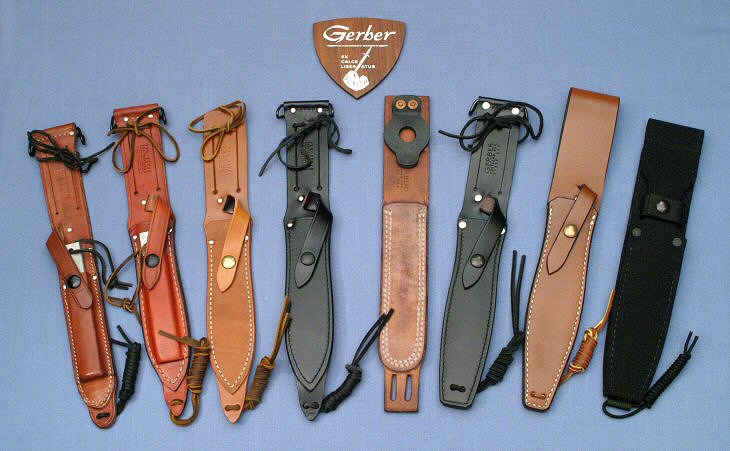|
Gerber sharpening steels are flat steel bars, approximately 5 inches long, 7/8 inch wide and 1/4 inch thick. The long outside edges are slightly rounded, have a rougher surface than the smoother flat sides and are intended as the main sharpening surface. The flat sides are intended for final honing. The bottom 1 inch is tapered to form a 7/8 inch wide chisel tip. The chisel tip can be used for hacking, prying or splitting. The top end is flat with a 1/4 inch (early) or 3/16 inch (later) diameter hole 5/8 inch from the top. The hole is threaded with a 10 inch length of leather tie looped to aid in extracting the steel from the sheath pocket.
Although commonly called sharpening steels, they are actually honing steels. Honing is a finishing operation. Small amounts of material are removed. It is not practical to perform substantial sharpening by honing.
Most have the Gerber name stamped at the top of the steel above the hole. The sharpener is forged from 0-1 tool steel. Chromium carbide is bonded to the surface and makes the tool hard enough to dress the edge of Gerber's high speed tool steel knives.
The sharpening steels can be found with Mark II leather sheaths with the steel pocket as well as in separate small leather scabbards and later in folding leather handles.
NOTE: The sharpening steels were also made in an 8 inch length in both the separate scabbard version and the folding handle version. With their longer length, the 8 inch versions were much easier to use. But probably due to their size and weight, the 8 inch versions are not as strongly associated with the Gerber Mark II.
Close-ups of the 5 inch steels are shown below.
There are four types of sharpening steels that are found with Gerber sheaths. I have coded them as follows:
NGSC - No Gerber - Square Corner LGSC - Large Gerber - Square Corner
SGSC - Small Gerber - Square Corner LGRC - Large Gerber - Round Corner
The NGSC steels are earliest steels and lack the Gerber name stamp. They have the same large diameter hole and square corners on both chisel edges as do the SGSC steels. They were issued in the early scabbards with only the simple Gerber name stamp. Some early knives may be found with these steels.
I was mistaken about these unmarked steels and assumed they were made by a different manufacturer. I've since obtained a near mint example with the early scabbard and paperwork which lists it from Gerber Legendary Blades, West Linn, Oregon, U.S.A.
![[SGSC Steel Image]](SteelSGSC.jpg)
The SGSC steels are the second sharpening steels. These steels have the Gerber name stamp with the small 0.10 inch high letters and have square corners on both chisel edges. The 1/4 inch hole at the top is slightly larger than the later Large Gerber steels. They are found with the round tip sheaths with steel pocket ("RTxS" sheaths) from 1967 to early 1971. They were also available in a small leather scabbard for knives that did not have the steel pocket.
The LGSC steels are the third type sharpening steel and are an intermediate form and relatively rare. These steels have the Gerber name stamp with the larger 0.17 inch high letters. The Gerber name was made larger for an unknown reason. At the same time the diameter of the hole at the top was made slightly smaller from 1/4 inch to 3/16 inch. They retain the square corners on both chisel edges.
There are few of the these LGSC steels because, at around this time, Gerber introduced the steel with a folding leather handle. The exposed square chisel corner presented a cutting hazard and were soon modified as explained under the LGRC description. The LGSC steels are found with both the separate leather scabbard and the early folding leather handle sharpeners.
The LGRC steels are the fourth version of the sharpening steel associated with the Mark II. These steels have the Gerber name stamp with the larger 0.17 inch high letters. The Gerber name was made larger for an unknown reason. They have the 3/16 inch (later) diameter hole. They also have a rounded corner on one chisel edge.
The rounded chisel end resulted when Gerber decided to eliminate the small leather scabbard and instead issue the steel with a folding leather handle. The handle is made such that the steel is sandwiched inside the handle and offset so that one of the long edges is exposed. A screw that passes through the leather handle and the hole in the steel holds the pieces together and acts as the pivot point. At some point Gerber must have received complaints that people were being cut by the sharp chisel edge exposed above the leather handle edge. Gerber's solution was to round the single exposed chisel edge. Rather than make two versions of the steel, the rounded chisel edge steels were also used with the leather scabbards and Mark II sheaths. They are found with some of the later RT5S round tip sheaths in 1971-1972 and the pointed-tip and flat-tip sheaths from 1973 until the end of Mark II leather sheath production in 1986.
|
![[Round-Tip Sheath 1 ]](SheathRT1t.jpg) Photo: Anonymous
Photo: Anonymous


![[Round-Tip Sheath 1S ]](SheathRT1St.jpg)
![[Round-Tip Sheath 2 ]](SheathRT2t.jpg)
![[Round-Tip Sheath 2 ]](SheathRT2St.jpg)
![[ Round-Tip Sheath 3 ]](SheathRT3t.jpg)
![[Round-Tip Sheath 3S ]](SheathRT3St.jpg)
![[Round-Tip Sheath 4 ]](SheathRT4t.jpg)
![[Round-Tip Sheath 4S ]](SheathRT4St.jpg)
![[Round-Tip Sheath 5 ]](SheathRT5t.jpg)
![[Round-Tip Sheath 5S ]](SheathRT5St.jpg)
![[Round-Tip Sheath 6 ]](SheathRT6t.jpg)
![[Round-Tip Sheath 6d ]](SheathRT6dt.jpg)
![[Round-Tip Sheath 6S ]](SheathRT6St.jpg)
![[Round-Tip Sheath 6Sd ]](SheathRT6Sdt.jpg)
![[Round-Tip Sheath 7 ]](SheathRT7t.jpg)
![[Round-Tip Sheath 8 ]](SheathRT8t.jpg)
![[Round-Tip Sheath 9 ]](SheathRT9t.jpg)
![[Pointed-Tip Sheath 1 ]](SheathPT1t.jpg)
![[Pointed-Tip Sheath 1S ]](SheathPT1St.jpg)
![[Pointed-Tip Sheath 2 ]](SheathPT2t.jpg)
![[Pointed-Tip Sheath 2S ]](SheathPT2St.jpg)
![[Pointed-Tip Sheath 3 ]](SheathPT3t.jpg)
![[Pointed-Tip Sheath 3S ]](SheathPT3St.jpg)
![[Pointed-Tip Sheath 4 ]](SheathPT4t.jpg)
![[Image Needed ]](SheathPT4St.jpg)
![[Pointed-Tip Sheath 5 ]](SheathPT5t.jpg)
![[Pointed-Tip Sheath 5S ]](SheathPT5St.jpg)
![[Flat-Tip Sheath 1 ]](SheathFT1t.jpg)
![[ Image Needed ]](SheathFT1St.jpg)
![[Flat-Tip Sheath 2 ]](SheathFT2t.jpg)
![[Flat-Tip Sheath 2S ]](SheathFT2St.jpg)
![[Cordura® Sheath 1 ]](SheathC1t.jpg)
![[Cordura® Sheath 1 ]](SheathC1St.jpg)
![[Cordura® Sheath 2 ]](SheathC2t.jpg)
![[Cordura® Sheath 3 ]](SheathC3t.jpg)
![[Cordura® Sheath 3S ]](SheathC3St.jpg)
![[Cordura® Sheath 4 ]](SheathC4t.jpg)
![[Cordura® Sheath 4S ]](SheathC4St.jpg)
![[Cordura® Sheath 5 ]](SheathC5t.jpg)
![[Slant 3 Logo ]](Slant3Logo.jpg)
![[Gerber Gear Logo ]](GerberGearLogo.jpg)
![[Presentation Sheath 1 ]](SheathP1t.jpg)
![[Presentation Sheath 2 ]](SheathP2t.jpg)
![[Dive1a ]](Dive1at.jpg)
![[Dive1b ]](Dive1bt.jpg)
![[Leather Dive Straps ]](SheathD1D2Bt.jpg)
![[Dive Sheath 2 ]](SheathD2t.jpg)
![[Dive Sheath 2 ]](SheathD2D3At.jpg)
![[Dive Type 3 ]](SheathD3t.jpg)
![[Rubber Dive Straps ]](SheathD3Bt.jpg)
![[Dive Type 4 ]](SheathD4At.jpg)
![[Dive Type 4 ]](SheathD4Bt.jpg)
![[Prototype Dive Sheath XSD1a ]](SheathXSD1at.jpg)
![[Prototype Dive Sheath XSD1b ]](SheathXSD1bt.jpg)
![[Prototype Presentation Sheath XSP1 ]](SheathXSP1t.jpg)
![[Unusual Sheath U1 ]](SheathUS1t.jpg)
![[Unusual Sheath US2 ]](SheathUS2t.jpg)
![[Stamp 2 Line ]](Stamp2line.jpg)
![[Stamp 3 Line ]](Stamp3line.jpg)
![[Stamp 20th ]](Stamp20th.jpg)
![[Stamp New Zip ]](StampNewZip.jpg)
![[Steel Gerber Stamp Image]](SteelGs.jpg)
![[Steel Corners Image]](SteelCorners.jpg)
![[NGSC Steel Image]](SteelNGSC.jpg)
![[SGSC Steel Image]](SteelSGSC.jpg)
![[LGSC Steel Image]](SteelLGSC.jpg)
![[LGRC Steel Image]](SteelLGRC.jpg)
![[Hanger ]](Hanger.jpg)
![[Blade Corrosion Image]](BlackRust.jpg)
![[Handle Damage Image]](AlOxide.jpg)